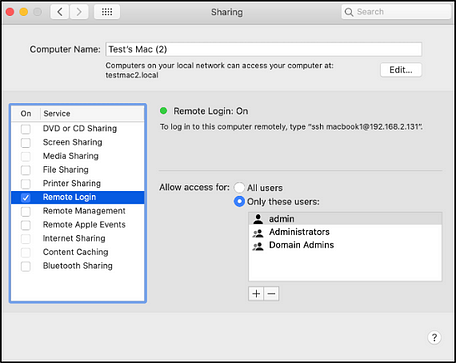

- Mac os active directory authentication mac os x#
- Mac os active directory authentication mac osx#
- Mac os active directory authentication full#
- Mac os active directory authentication windows#
Mac os active directory authentication mac os x#
When this option is used, Mac OS X generates a UID at login based on the GUID (Globally Unique Identifier) attribute from the users Active Directory account. The first and default option is to dynamically generate a UID for each user when they log in. But there is no directly correlating attribute in Active Directory.Īpple provides a choice of two methods to providing Active Directory users a UID attribute. As in other Unix systems, the UID is used by the Mac OS X file system to designate file ownership and permissions both for local and remote files.Įach local or network user account used to log into Mac OS X requires a UID. One of the key attributes in the Open Directory schema used by Mac OS X is the User ID number (UID).

One of the hurdles to integrating Mac OS X with Active Directory is that their directory services schemas are significantly different. Mac OS X can search multiple directory configurations in a specified path when a user attempts to log in. You will also need to configure the search path of available directories to include Active Directory using the Authentication tab in the Directory Access tool. Youll need an Active Directory account with permission to join the computer to the domain if the account was not created in advance, youll need authority to create it.

Mac os active directory authentication windows#
The process of using the plug-in to join a Mac to an Active Directory domain is straightforward, and is similar to joining a Windows computer to a domain. Depending on your environment, you may also want to be able to implement security measures to limit what users may do while logged into a Mac or to manage the user experience as you would do with group policies for Windows machines. Although Apple has used Samba to make it easy for Macs to browse and access shares and printers hosted by Windows servers using Microsofts server message block (SMB) protocol, true Active Directory integration requires more than just access to resources.įor one thing, it requires support for an environment where users can rely on their Active Directory accounts for log-in to both Mac and Windows computers. Supporting Mac users can be a challenge to systems administrators in a Windows Active Directory environment. We have confirmed with Apple that this is no longer the case the story is corrected below.
Mac os active directory authentication mac osx#
I'm able to join MAC OSX to Windows AD so it has a computer account on AD.Editor's note: When originally published this article said that by using dynamic user identification (UID) generation, users might be assigned a different UID number each time they logged onto a different Mac. With MAC OSX, I can't figure out how it behaves. The goal is to prevent non-AD devices from connecting to wifi.
Mac os active directory authentication full#
Hence, machine + user auth combination can be tied to a particular role on CPPM to give user full wifi access. If user successully authenticates, CPPM will checks its cached for machine MAC which passes machine auth earlier and ties it to user auth. Once user logs in, user cert is used for authentication. In my case, since client supplicant is configured with EAP-TLS, it will use machine cert for machine authentication. It either uses machine cert or AD computer account for machine authentication. With Windows, my understanding is when it boots up (before user logs in), machine authentication happens.

Do any of you guys know how MAC devices behave in regards to EAP-TLS machine authentication? However, I'm having trouble with MAC OSX and machine authentication. Enforce machine authentication is done on CPPM. EAP-TLS with 'enforce machine authentication' works perfectly with Windows 7.


 0 kommentar(er)
0 kommentar(er)
